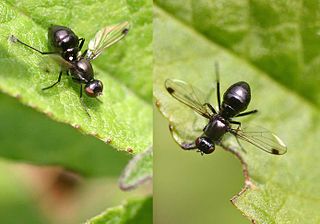
The Sepsidae are a family of flies, commonly called the black scavenger flies or ensign flies. Over 300 species are described worldwide. They are usually found around dung or decaying plant and animal material. Many species resemble ants, having a "waist" and glossy black body. Many Sepsidae have a curious wing-waving habit made more apparent by dark patches at the wing end.

The Ulidiidae or picture-winged flies are a large and diverse cosmopolitan family of flies (Diptera), and as in related families, most species are herbivorous or detritivorous. They are often known as picture-winged flies, along with members of other families in the superfamily Tephritoidea that have patterns of bands or spots on the wings. Some species share with the Tephritidae an unusual elongated posteroapical projection of the anal cell in the wing, but can be differentiated by the smoothly curving subcostal vein. Two species, Tetanops myopaeformis and Euxesta stigmatias, are agricultural pests.

The Acartophthalmidae are a family of very small (1.0-2.5 mm), dark flies with pubescent arista, placed in the order Diptera. All are Holarctic in distribution. Two fossil species are known, with uncertain placement.
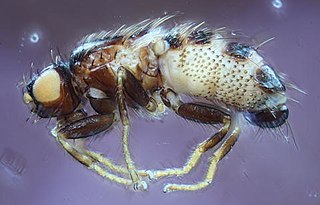
Carnus hemapterus is a Dipteran insect, a small-bodied and partly black-coloured carnid fly. In their adult stage of life, they are blood-sucking ectoparasites of nestling birds. Within the genus Carnus, this is the only species widespread across Europe and the cold and temperate regions of Asia and North America. Female body length is about 1.5 mm, males are smaller. It typically occurs in the nests of medium- to large-bodied birds, provided that the nest is not on the ground. It is particularly common on the chicks of owls, falcons, rollers, bee-eaters and starlings. Females give birth to larvae that live within the nest and feed on organic debris and the pupae also overwinter there. The emergence of imagines is synchronized to the hatch of host nestlings in the subsequent year. They prefer larger chicks within the nest. Adult flies have a winged and an unwinged variety, the latter being more common. In fact, unwinged flies still carry the basal part of their wings, but the majority of the wing is broken off. Flies live only on the nestlings before and during the development of the plumage, and disappear later on.

Besseria is a genus of flies in the family Tachinidae.
Graphogaster is a genus of flies in the family Tachinidae.
Rhamphina is a genus of bristle flies in the family Tachinidae.

Loewia is a genus of flies in the family Tachinidae.
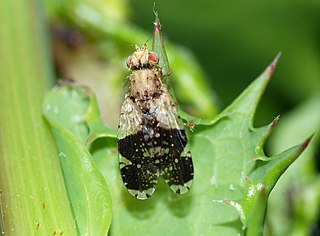
Tephritis is a genus of flies. It contains around 170 described species, making it the sixth largest genus in the family Tephritidae. Many more undescribed species are known from specimen collections. Tephritis occur throughout much of the world, but most are Palearctic. They can be found in a wide range of climate types, from hot semidesert to tundra. Most species inhabit the inflorescences of plants from several tribes in the family Asteraceae, and a few species cause galls to form.
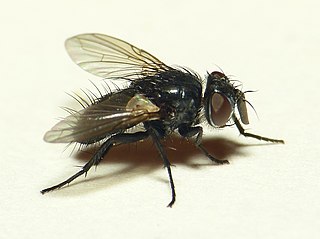
Blondeliini is a tribe of parasitic flies in the family Tachinidae. Larvae are parasitoids of other insects, mostly beetles and caterpillars. Although nearly cosmopolitan, its greatest diversity is in the New World and especially in South America.
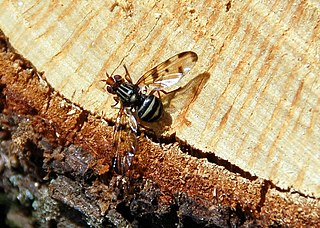
Otitinae is the name of a subfamily of flies in the family Ulidiidae. It was formerly the Otitidae. Like the Ulidiinae, most species are herbivorous or saprophagous. Most species share with the Tephritidae an unusual elongated projection of the anal cell in the wing, but can be differentiated by the smoothly curving subcostal vein. Most are dull gray to shiny brown or black flies with vein R1 setulose or, in a few cases, bare.

Carnus is a genus of flies (Diptera) with 5 described species, all of which are parasites of birds. The adult flies locate a suitable host nest, then shed their wings and feed on the blood of the developing nestlings. Mature female flies lay their eggs in the nest, where their larvae develop on organic detritus.
Hemeromyia is a genus of flies (Diptera).
Meoneura is a genus of carnid flies (Diptera).
Meoneurites is an extinct genus of flies (Diptera). There is a single described species.
Neomeoneurites is a genus of flies (Diptera). There are 2 described species.

The Cryptochetidae are a small family of tiny flies. Some twenty to thirty species are known. Generally they are metallic blue black, stoutly built, with the head broad and high and with clear wings. Like other species in the superfamily Lonchaeoidea, the Cryptochetidae have antennae with a cleft in the second segment. Unlike practically all Schizophora however, they lack an arista, or if they do have one, it is too small to distinguish with any confidence. The family name refers to this unusual distinction; "Cryptochetidae" literally means "those with hidden bristles". The adult flies also are unusual among insects in that they have only a single pair of abdominal spiracles — this is not a serious physiological challenge in such small insects.
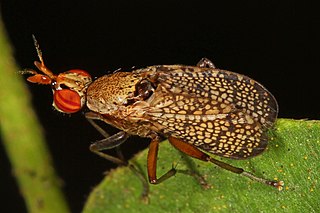
Tetanocerini is a tribe of flies in the family Sciomyzidae. There are more than 400 described species in the tribe.
Phanerochaetum is a genus of flies in the family Cryptochetidae. There is one described species Phanerochaetum tuxeni.
Protorygma is an extinct genus of flies in the family Sepsidae.











